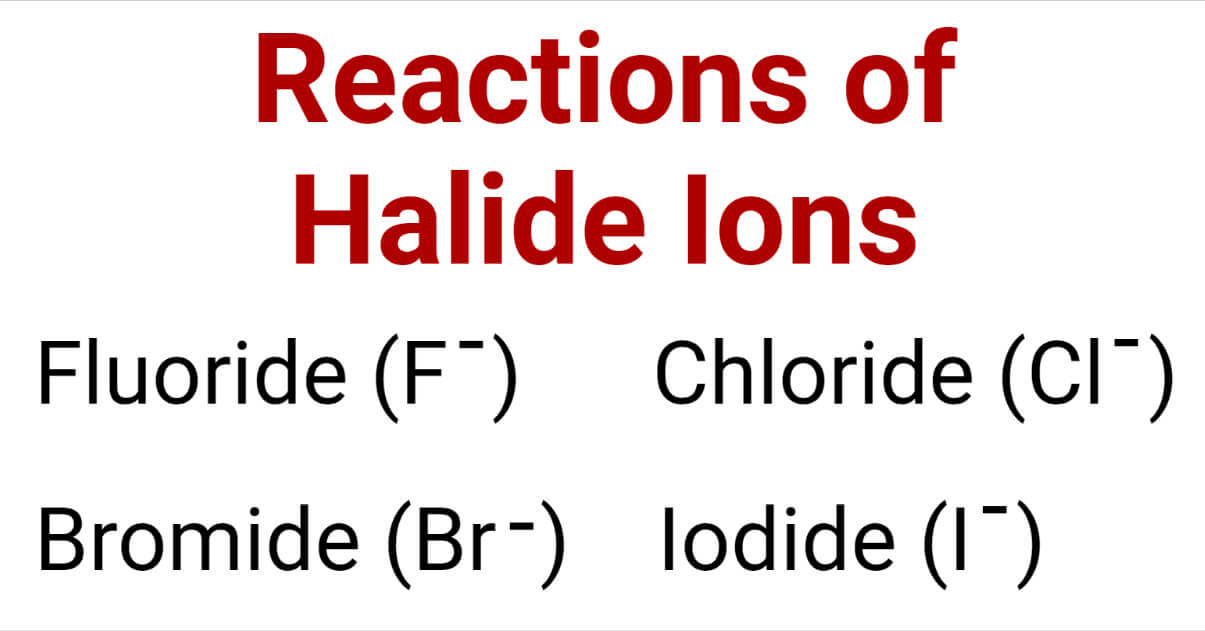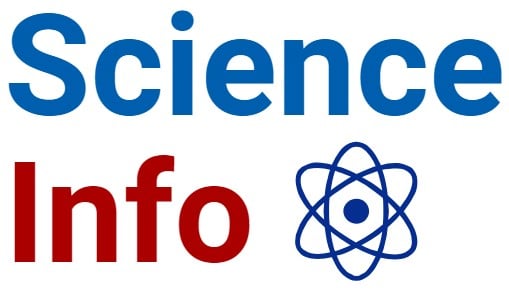A halide ions is a negatively charged anion formed by a halogen atom. They have a (-1 ) charge. A halide is also a compound composed of a halogen atom bonded to a less electronegative species.
Halide Ions include fluoride (F–), chloride (Cl–), bromide (Br–), and iodide (I–).
Interesting Science Videos
Halide Ions: Reducing Agents
A reducing agent oxidizes itself while reducing another species. Halide ions have the ability to act as reducing agents. The halide ions themselves oxidize and lose electrons.
As you move down the periodic table, halides become better reducing agents. This pattern can be explained by the following points:
- The halide ions become larger as one moves down the group.
- The electrons on the periphery move away from the nucleus. The outermost electrons are also shielded more by the inner electrons.
- As a result, the positively charged nucleus outermost electrons are held less tightly.
- As a direct consequence, halide ions lose electrons more easily as they move down the group, and their reducing power increases.

Reaction of Halide Ions with Sulphuric Acid
All of the halide ions react with concentrated sulfuric acid, but the products vary. This is determined by the halide used. Some halides can reduce sulfur in sulfuric acid, while others cannot.
Reaction of Fluoride ions and Sulphuric Acid
| Chemical Reaction | 2NaF (s) + H2S04 (l) → Na2SO4 (s) + 2HF (g) |
| Description | When sodium fluoride reacts with concentrated sulfuric acid, hydrogen fluoride and sodium hydrogensulfate are formed. This is an acid-base reaction Note: This is not a redox reaction because fluoride ions are not a powerful enough reducing agent to reduce the sulfur in sulfuric acid. |
| Observation | We will observe the white solid of sodium hydrogensulfate and the steamy fumes of hydrogen fluoride. |
Reaction of Chloride ions and Sulphuric Acid
| Chemical Reactions | 2NaCl (s) + H2S04 (l) → NaHSO4 (s) + HCl (g) |
| Description | Sodium chloride has a similar reaction to sodium fluoride. Chloride ions are insufficient to reduce sulfur dioxide. The reaction is an acid-base reaction. |
| Observation | It produces steamy white hydrogen chloride fumes and the white solid sodium hydrogensulfate |
Reaction of Bromide ions and Sulphuric acid
As we know, the periodic table’s reducing ability increases with decreasing group size. Therefore this means that bromide ions are far superior to fluoride and chloride ions as reducing agents. Bromide ions, can reduce sulfuric acid.
| Chemical Reaction | NaBr (s) + H2S04 (l) → NaH2SO4 (s) + HCl (g) |
| Description | When sodium bromide reacts with sulphuric acid same reaction occurs at first which is an acid-base reaction. The reaction continues after this because HBr is a strong enough reducing agent to react with H2SO4 in a redox reaction |
| Observation | The misty fumes indicate the formation of hydrogen bromide gas in the first reaction. |
| Redox Reaction | 2HBr (aq) +H2SO4 (l) → Br2 (g) + SO2 (g) + 2H2O (l) Oxidation state of S: (+6) to (+4) Oxidation state of Br: (-1) to (0) |
| Description | Bromide ions are oxidized after losing electrons and sulfur is reduced after gaining electrons. |
| Observation | Sulfur dioxide gas is produced as choking fumes, and bromine gas is produced as orange fumes. |
Reaction of Iodide ions and Sulphuric acid
The trend continues down the group – iodide ions reduce other species even better than bromide ions.
| Chemical Reaction | NaI (s) + H2SO4 (l) → NaH2SO4 (s) + HI (g) |
| Description | Firstly, an acid-base reaction generates hydrogen iodide. |
| Observation | Misty fumes of hydrogen iodide are observed. |
| Redox reaction (1) | 2HI (aq) + H2SO4 (l) → I2 (g) + SO2 (g) + 2H2O (l) Oxidation state of S: (+6) to (+4) Oxidation state of I: (-1) to (0) |
| Description | The sulfur is reduced from an oxidation state of +6 in sulfuric acid to +4 in sulfur dioxide by iodide ions as it is strong reducing agent |
| Redox reaction (2) | 6HI (aq) + SO2 (g) → 3I2 (s) + H2S (g) + 2H2O (l) Oxidation state of S: (+4) to (+2) Oxidation state of I: (-1) to (0) |
| Description | Because hydrogen iodide is a more powerful reducing agent, it further reduces SO2 to H2S. Hence, iodine solid is formed. |
| Observation | H2S has an eggy smell and it is a toxic gas. |
Reaction of Halide ions with silver nitrate and ammonia solutions
Halide ions in an unknown solution can be identified by dissolving them in nitric acid and then adding a silver nitrate solution followed by an ammonia solution. Hence, these reactions are used for the test of halides.
AgNO3(aq) + X–(aq) → AgX(s) + NO3–(aq) [General equation]
Ag+(aq) + X–(aq) → AgX(s) [Ionic equation]
| Halide Ions | Reaction Observation | Precipitate formed |
| Cl– (aq) | Dissolves in both the dilute and concentrated ammonia solution | White |
| Br–(aq) | Remains insoluble in dilute ammonia solution but dissolves in the concentrated ammonia solution | Cream |
| I–(aq) | Remains insoluble in both the dilute and concentrated ammonia solution | Pale yellow |
If the unknown solution contains halide ions, a silver halide precipitate will form (AgX).
X– (aq) + AgNO3 (aq) → NO3– + AgX
Here, X– is a halide ion.
Ammonia role in reaction
- Ammonia reacts with silver ions to form a complex ion known as diamminesilver(I), [Ag(NH3)2]+. This is a reversible reaction, but the complex is very stable, and the equilibrium position is far to the right.
- A solution that has come into contact with one of the silver halide precipitates contains very little dissolved silver ions. The addition of ammonia reduces this concentration even further. If the solubility product is less than the adjusted silver ion concentration multiplied by the halide ion concentration, some precipitate dissolves to restore equilibrium.
- This occurs with silver chloride, and with silver bromide if the ammonia is concentrated. The higher the concentration of ammonia, the further the equilibrium shifts to the right, lowering the silver ion concentration.
- Because silver iodide is so insoluble, ammonia cannot lower the silver ion concentration sufficiently to dissolve the precipitate.
References
- Smith, D. (1990). Inorganic Substances: A Prelude to the Study of Descriptive Inorganic Chemistry (Cambridge Texts in Chemistry and Biochemistry). Cambridge: Cambridge University Press. doi:10.1017/CBO9780511622922
- Lee, J D. Concise Inorganic Chemistry. London: Blackwell Science, 2006. Print.
- Cotton, F A, and F A. Cotton. Advanced Inorganic Chemistry. , 1999. Print.
- https://www.savemyexams.co.uk/as/chemistry/cie/22/revision-notes/2-inorganic-chemistry/2-3-group-17/2-3-3-reactions-of-the-halide-ions/
- https://chem.libretexts.org/Bookshelves/Inorganic_Chemistry/Supplemental_Modules_and_Websites_(Inorganic_Chemistry)/Descriptive_Chemistry/Elements_Organized_by_Block/2_p-Block_Elements/Group_17%3A_The_Halogens/1Group_17%3A_General_Reactions/Halide_Ions_as_Reducing_Agents
- https://studymind.co.uk/notes/halide-ions-and-their-reactions/
